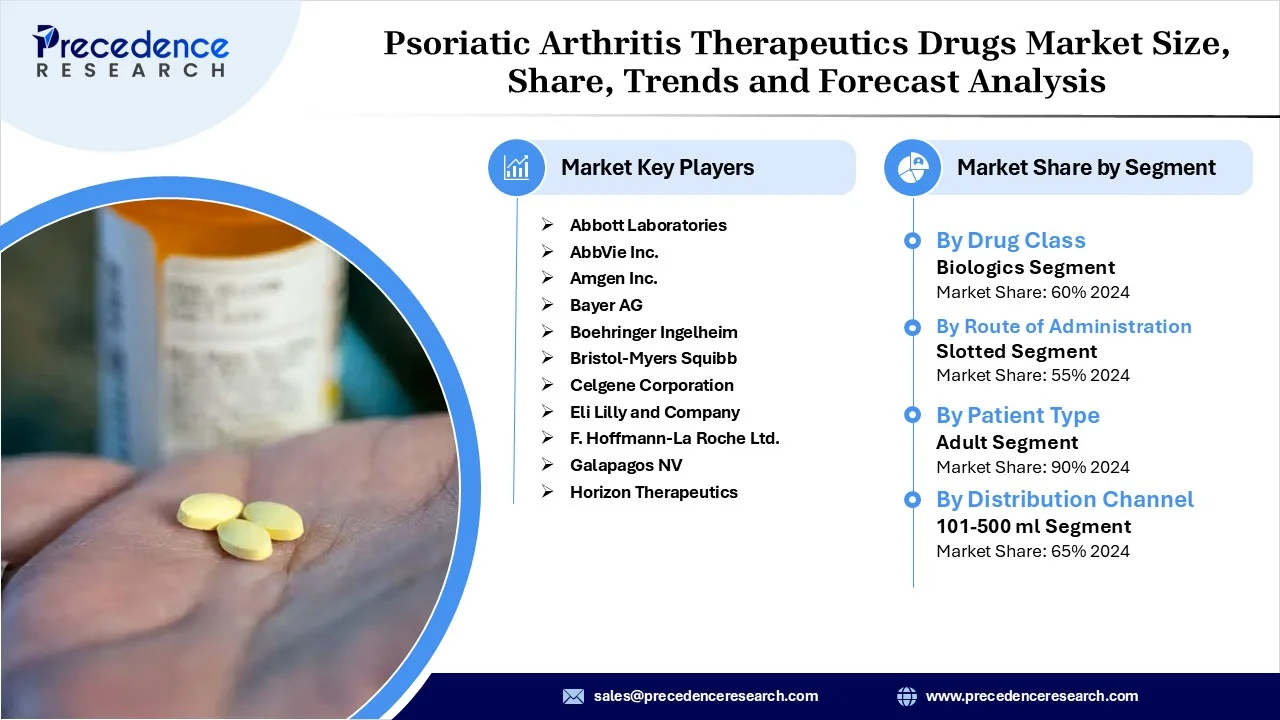The psoriatic arthritis therapeutics drugs market has experienced stable growth in recent years, owing to the increased need for better diagnosis and advanced treatments. Moreover, the shift from the basic pain relievers to the technologically advanced treatments is contributing to the industry's growth in recent years. Also, the market is benefiting from global R&D activities in the current period.

Market Opportunities
- The development of orally targeted drugs is anticipated to create significant opportunities for manufacturers in the coming years.
- The creation of personalized medicines is likely to provide greater industry attention to the manufacturers in the upcoming years.
Key Growth Factors
- The emergence of biosimilars has actively driven the industry's potential in recent years.
- The integration of digital health in recent treatments is immeasurably contributing to the market growth in the current period.
Market Restraint
- The higher cost of advanced drugs is expected to hamper industry growth in the upcoming market phases.
- Safety and regulatory challenges are likely to create growth barriers for the industry's potential in the coming years.
Segmental Insights
Drug Class Insights
What Made the Biologics Segment Dominant in the Psoriatic Arthritis Therapeutics Drugs Market in 2024?
The biologics segment generated the greatest revenue share in 2024, owing to factors such as the superior effectiveness in inflammation reduction and prevention of joint damage. Also, by targeting pathways of the immune system, biologics have gained major industry attention in recent years.
Route of Administration Insights
The injectable segment marked its dominance due to the injectables and infusion being considered the ideal route of treatment. Also, by providing faster action and relief than oral doses, the injectable form has gained a sophisticated consumer base in recent years.
Patient Type Insights
The adult segment marked its dominance because psoriatic arthritis is most commonly diagnosed between the ages of 30 and 50. This is the peak working-age population, making treatment crucial to maintain quality of life and productivity. Children and adolescents are much less likely to develop PSA, resulting in smaller demand in those groups.
Distribution Channel Insights
The hospital pharmacies segment marked its dominance because most advanced PsA therapies, especially biologics, are administered under medical supervision. Hospitals are primary treatment centers where patients receive infusions or injections and require monitoring for potential side effects. Doctors also prefer prescribing biologics through hospital-linked pharmacies for safety and regulatory compliance.
Geographical Outlook
North America
North America dominated the psoriatic arthritis therapeutics drugs market owing to greater healthcare infrastructure and early adoption of targeted therapies. Moreover, factors like higher diagnosis rates and enlarged spending on drug discovery and R&D activities, the region has maintain its dominance in the current global industry environment. Furthermore, the greater government support for healthcare expenditure is likely to create significant opportunities for the healthcare sector in the upcoming years.
Asia Pacific
Asia Pacific is expected to emerge at the fastest CAGR during the forecast period of 2025 to 2034, due to an enlarged patient base and technology adoption. Moreover, the regional countries like India and China have been identified as having the largest psoriasis and arthritis patient rates, where effective treatment is likely to get greater attention in the coming years.
Strategic Moves by Key Players
- In July 2025, Johnson & Johnson announced the submission of a supplemental Biologics License Application (sBLA) to the U.S. Food and Drug Administration (FDA) seeking approval to update the label of TREMFYA (guselkumab) for inhibition of structural damage progression in adults with active psoriatic arthritis (PsA). The submission is based on positive Phase 3b APEX study results, where TREMFYA achieved its primary endpoint of reducing joint symptoms (ACR20) and its key secondary endpoint of slowing radiographic progression, measured by change in the modified van der Heijde-Sharp (vdH-S) score at 24 weeks versus placebo in bio-naïve patients. These findings were presented at the European Alliance of Associations for Rheumatology (EULAR) 2025 Congress.
- In July 2025, the U.S. Food and Drug Administration (FDA) accepted for review a supplemental New Drug Application (sNDA) for deucravacitinib in treating adults with active PsA. Deucravacitinib, a selective tyrosine kinase 2 (TYK2) inhibitor, is already marketed as Sotyktu for adults with moderate-to-severe plaque psoriasis who are candidates for systemic therapy or phototherapy.
Psoriatic Arthritis Therapeutics Drugs Market Companies
- Abbott Laboratories
- AbbVie Inc.
- Amgen Inc.
- Bayer AG
- Boehringer Ingelheim
- Bristol-Myers Squibb
- Celgene Corporation
- Eli Lilly and Company
- F. Hoffmann-La Roche Ltd.
- Galapagos NV
- Horizon Therapeutics
- Johnson & Johnson (Janssen)
- Novartis AG
- Pfizer Inc.
- Pfizer/BioNTech
- Regeneron Pharmaceuticals
- Samsung Bioepis
- Sanofi
- Takeda Pharmaceutical Company
- UCB Pharma
Segments Covered in the Report
By Drug Class
- Conventional DMARDs(cDMARDs)
- Methotrexate
- Leflunomide
- Sulfasalazine
- Hydroxychloroquine
- Biologics
- TNF Inhibitors
- Adalimumab
- Etanercept
- Infliximab
- Certolizumab
- IL-17Inhibitors
- IL-12/23 Inhibitors
- Other Biologics
- Targeted Synthetic DMARDs (tsDMARDs)
- Apremilast
- Tofacitinib
- Upadacitinib
- Others
- NSAIDs
- Corticosteroids
By Route of Administration
- Oral
- Conventional DMARDs
- tsDMARDs
- Injectable
- Biologics
- Corticosteroids
By Patient Type
By Distribution Channel
- Hospital Pharmacies
- Retail Pharmacies
- Online Pharmacies
By Region
- North America
- Europe
- Asia Pacific
- Latin America
- Middle East & Africa
Source: https://www.precedenceresearch.com/psoriatic-arthritis-therapeutics-drugs-market

